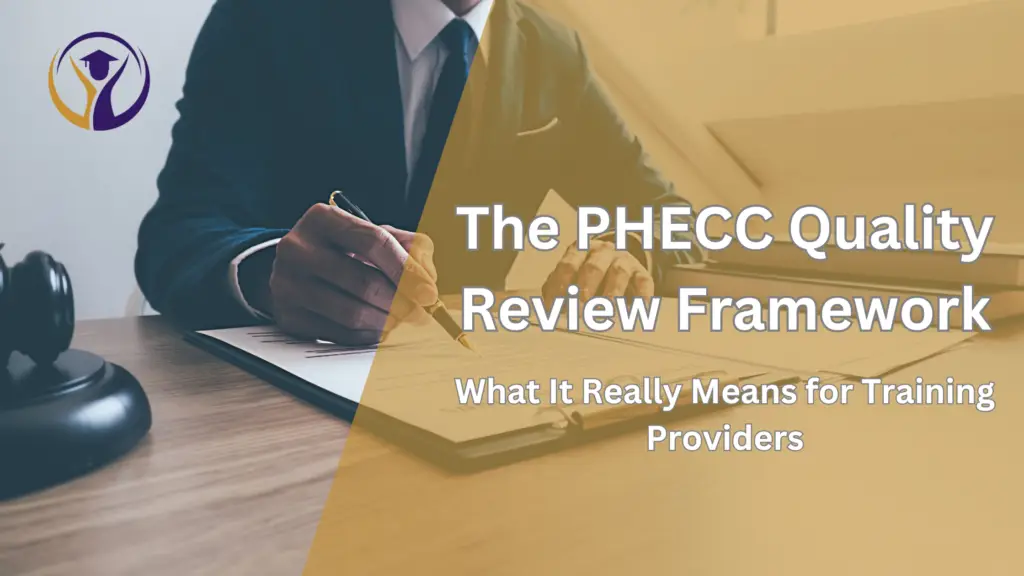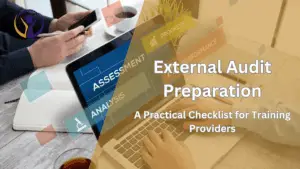In our last blog post, we explored how the PHECC Quality Review Framework (QRF) connects with digital certification and national standards. While that’s helpful for context, today’s post is more hands-on.
Many Approved Training Institutions (ATIs) ask:
“What does the QRF mean for us day to day?”
“How do we actually apply it without getting overwhelmed?”
If you’ve asked the same, you’re in the right place. This follow-up guide will help you break the QRF down into practical steps. You’ll see where providers commonly run into trouble, and you’ll get clear, actionable tips on how to stay on track.
So, What Is the PHECC QRF in Plain English?
The PHECC QRF is the quality assurance system used by the Pre-Hospital Emergency Care Council (PHECC) to assess and monitor ATIs and Recognised Institutions. It helps ensure that training providers:
- Deliver consistent, high-quality education
- Have proper governance and faculty systems in place
- Continuously improve how they support learners
It’s made up of:
- 6 core standards
- 44 assessment criteria
- A 5-point rating system from “Not Met” to “Fully Met”
- Self-assessment tools and external site visits
📘 You can access the full official guidance here on the PHECC Quality Review Framework page.
The Six QRF Standards (And What They Mean Day to Day)
Here’s a plain-language look at each standard:
1. Effective Governance
Do you have a leadership structure? Are roles and responsibilities clearly defined? Are your policies version-controlled and reviewed?
👉 CQAS can support you with QA system development and governance documentation.
2. Course Development and Maintenance
Are your courses aligned with PHECC standards? Do you review your content regularly?
👉 We offer documentation support to help keep course materials up-to-date and audit-ready.
3. Delivery of Education
Are your instructors qualified? Are your locations suitable? Are learners getting a consistent and fair experience?
👉 Our Assessment Management Service makes instructor tracking and delivery planning simple.
4. Student Support
Do your learners know where to go for help? Do you provide guidance for appeals, complaints, or blended learning issues?
👉 Try our Internal Education Audit to review your learner-facing policies and supports.
5. Assessment and Course Outcomes
Are your assessments fair, valid, and consistent? Do you verify results? Is there evidence of Internal Verification (IV) and External Verification (EV)?
👉 We can streamline your assessment and verification systems to make this less stressful.
6. Learning Organisation
Are you reviewing your own performance and using feedback to improve? Do you have a continuous improvement plan?
👉 Our Outsourced Quality Assurance service is ideal for small to medium ATIs that need ongoing support without hiring full-time QA staff.
How the PHECC QRF Is Scored (And What You Need to Watch Out For)
Each of the 44 QRF criteria is rated using this 5-point scale:
- 4 – Fully Met
- 3 – Substantively Met
- 2 – Moderately Met
- 1 – Minimally Met
- 0 – Not Met
To pass, you need to score more than 63% overall — but if you receive too many 0s or 1s in any individual standard, you risk automatic failure of that section (even if your overall score looks OK).
PHECC assessors also apply a risk matrix to evaluate how serious any gaps are, especially if there’s potential for harm to learners or the public.
Where Most Providers Struggle
In our work with ATIs across Ireland, the most common gaps we see are:
❌ No version-controlled policies
❌ Incomplete or outdated tutor files
❌ Weak Internal Verification records
❌ No documented CPD tracking
❌ Feedback collected but never acted on
❌ No improvement plan post-site visit
This is why many providers choose to work with us through our Outsourced Quality Assurance system, where we handle everything from documentation to internal audits.
CQAS: Helping You Prepare, Perform, and Improve
Whether you’re new to the QRF or due a reapproval site visit, CQAS can support you through every stage, including:
- Full internal audits using PHECC’s scoring system
- Evidence folder setup
- Tutor and faculty file templates
- CPD tracking systems
- Blended learning compliance
- Post-audit improvement planning
📩 Get in touch for a free discovery call — we’ll review your current setup and suggest realistic next steps.
Final Thoughts: The QRF Is a Roadmap, Not Just a Regulation
When used well, the PHECC Quality Review Framework becomes more than a checklist — it becomes a tool to future-proof your training centre. It helps you build trust, support your learners, and maintain your recognition status without burning out.
If you want to move from reactive to proactive quality assurance, we’re here to help.




